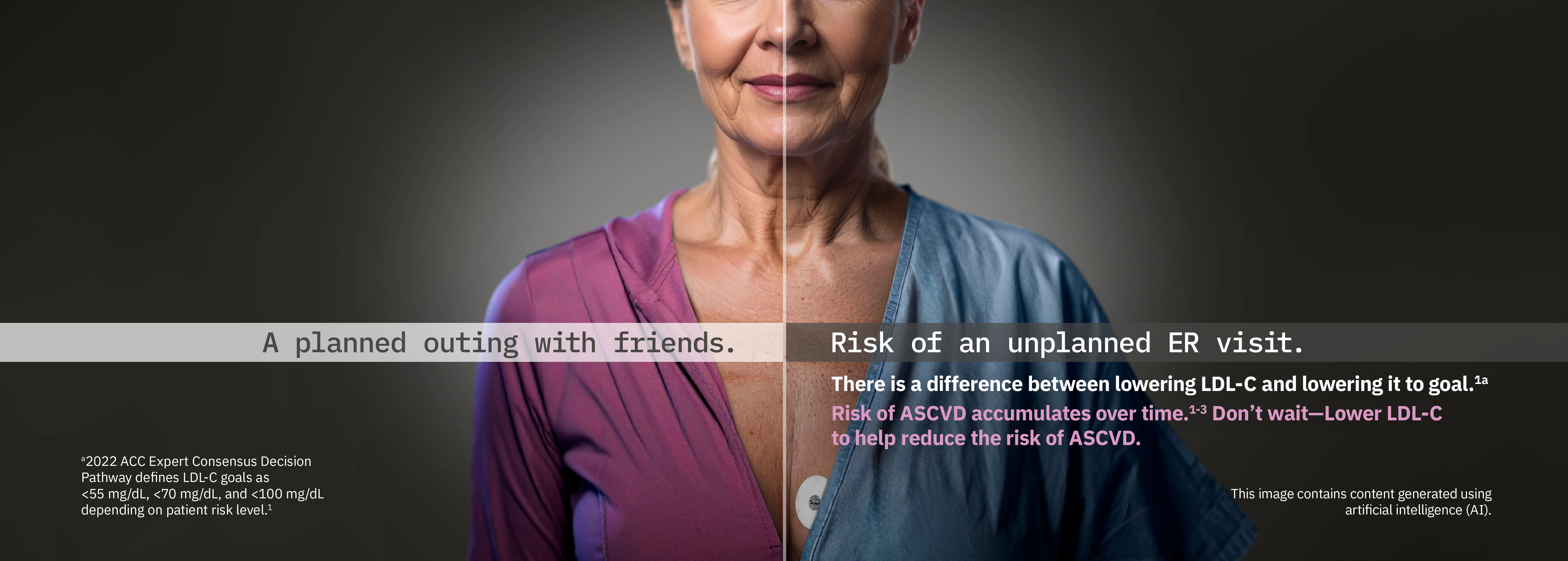This site is intended for US Healthcare Professionals Only.

Support your patients by helping them get to goal
A survey questionnaire of 4452 patients with ASCVD and LDL-C above goal showed that ~71% were unaware of their LDL-C goal4b
bData based on structured questionnaires conducted in 5006 US outpatients with ASCVD (4452 with suboptimal LDL-C) and 113 physician providers from 119 sites, as part of the GOULD registry, collected between December 2016 and July 2018. Suboptimal LDL-C cohort had the following makeup: mean age of 68 +/- 9.9 years, 60.9% male, 85.5% White race, 12.2% current smokers, mean LDL-C of 101.1 +/- 29.8 mg/dL, average BMI of 30.6 +/- 6.2 kg/m2, and average estimated 10-year risk of recurrent ASCVD events was 26.4 +/- 19.2%.4
Prioritize LDL-C and help get your patients to LDL-C goal1
Set
Set specific guideline-recommended LDL-C goal
Inform
Inform patients about their LDL-C goal AND the importance of achieving it
Remind
Remind patients of their LDL-C goal during routine visits
A projection model suggests that achieving LDL-C goal may reduce ASCVD mortality5c
This model utilized information on 596 participants in the 2009-2010, 2011-2012, 2013-2014, and 2015-2016 NHANES data cycles on the estimated number of adults with ASCVD and the 10-year incidence of ASCVD from an analysis of 5390 participants from the REGARDS study.5
cBased on a projected number of recurrent ASCVD events over the course of 10 years among US adults aged ≥45 years with a history of ASCVD and LDL-C ≥70 mg/dL, and a predicted number of ASCVD events if those adults reduced and maintained LDL-C to <70 mg/dL. Estimated number of adults with ASCVD was based on data from the 2009-2010, 2011-2012, 2013-2014, and 2015-2016 NHANES cycles. The 10-year cumulative incidence of ASCVD events was estimated using data from the REasons for Geographic and Racial Differences in Stroke (REGARDS) study. Limitations to this study included that the estimated cumulative incidence of ASCVD and cardiovascular death relied on data from the REGARDS study, which only enrolled non-Hispanic White and non-Hispanic Black participants, the current analysis was restricted to adults ≥45 years of age, and the study predicted a uniform LDL-C reduction to 69 mg/dL, which may underestimate the benefit of population-wide achievement of LDL-C <70 mg/dL.5
By prioritizing earlier LDL-C management through intervention, patient awareness, and getting patients to their LDL-C goal, HCPs may help reduce ASCVD risk.1-5
ACC ECDP=American College of Cardiology Expert Consensus Decision Pathway; ASCVD=atherosclerotic cardiovascular disease; BMI=body mass index; GOULD=Getting to an imprOved Understanding of Low-Density Lipoprotein-Cholesterol and Dyslipidemia Management; LDL-C=low-density lipoprotein cholesterol; NHANES=National Health and Nutrition Examination Survey.
References: 1. Writing Committee; Lloyd-Jones DM, Morris PB, et al. 2022 ACC Expert Consensus Decision Pathway on the Role of Nonstatin Therapies for LDL-Cholesterol Lowering in the Management of Atherosclerotic Cardiovascular Disease Risk: A Report of the American College of Cardiology Solution Set Oversight Committee. J Am Coll Cardiol. 2022;80(14):1366-1418. doi:10.1016/j.jacc.2022.07.006 2. Domanski MJ, Tian X, Wu CO, et al. Time Course of LDL Cholesterol Exposure and Cardiovascular Disease Event Risk. J Am Coll Cardiol. 2020;76(13):1507-1516. doi:10.1016/j.jacc.2020.07.059 3. Ference BA, Braunwald E, Catapano AL. The LDL Cumulative Exposure Hypothesis: Evidence and Practical Applications. Nat Rev Cardiol. 2024;21(10):701-716. doi:10.1038/s41569-024-01039-5 4. Arnold SV, Cannon CP, de Lemos JA, et al. What Do US Physicians and Patients Think About Lipid‐Lowering Therapy and Goals of Treatment? Results From the GOULD Registry. J Am Heart Assoc. 2021;10(16):e020893. doi:10.1161/jaha.120.020893 5. McKinley EC, Bittner VA, Brown TM, et al. The Projected Impact of Population-Wide Achievement of LDL Cholesterol <70 mg/dL on the Number of Recurrent Events Among US Adults With ASCVD. Cardiovasc Drugs Ther. 2023;37(1):107-116. doi:10.1007/s10557-021-07268-x
